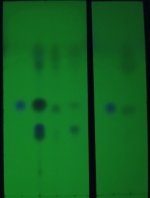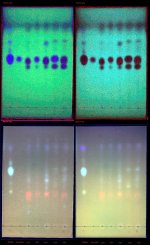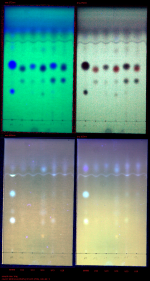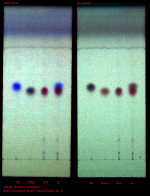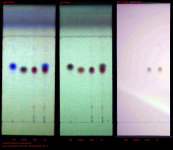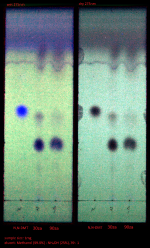Grasshoppers
Titanium Teammate
Preamble
Grasses, enduring through the ages, have flourished upon the earth, unravelling the fabric of reality to reveal the underlying essence of the cosmos. With each seed sown and every plant nurtured, nature's mysteries unfold before us, guiding us toward a promising tomorrow.
Within this discourse, we shall explore our methodology for selecting and cultivating Phalaris, offering our insights and expertise to the psychedelic community. As our plants take root and flourish, we hope they will emerge as beacons of progress, illuminating the path forward by dispelling the shadows of ignorance and ushering in enlightenment.
Project Methodology Overview
The project methodology encompasses the systematic selection, controlled breeding, and cultivation of Phalaris specimens sourced globally. This selection process is facilitated through Thin-Layer Chromatography (TLC) and bioassay techniques for the identification of desirable traits.
Selected specimens undergo controlled breeding procedures, aimed at consolidating and enhancing the desired genetic characteristics. Through deliberate mating, the genetic pool is manipulated to produce offspring with optimal traits.
Subsequently, the cultivated offspring undergoes rigorous selection process to further refine desirable attributes, ensuring the propagation of superior genetic material.
In light of our commitment to inclusivity and accessibility, it is imperative that our research methods remain practical and cost-effective. By utilizing easy-to-use and readily available techniques, we ensure that individuals from diverse backgrounds can actively participate in the project.
A key aspect in this programme involves the creation and dissemination of new phalaris breeds consolidated as cultivars to the psychedelic community. By sharing these plants, we aim to facilitate collaborative research endeavors and foster innovation.
Current Project Status
Recent TLC analysis has identified several promising strains of Phalaris aquatica, showing strong potential for further development in our breeding program.
One particularly promising 5-MeO-DMT-dominant accession has been identified, which can be propagated by seed. The parent plants, grown in USDA Climate Zone 9, have successfully passed bioassay testing, confirming both their potency and safety.
Additionally, we have discovered a 5-MeO-DMT-dominant clone from a separate accession, exhibiting potency levels seldom seen in wild populations. This clone thrives in USDA Climate Zones 7 and above and has already undergone bioassay testing, validating its psychedelic properties.
Key Findings
Contribute
We welcome individuals who are willing and capable of supporting the breeding project. At its current stage, you can contribute if:
Open Research Topics
Supplementary Material
See also
Last Update
2025/05/01
Grasses, enduring through the ages, have flourished upon the earth, unravelling the fabric of reality to reveal the underlying essence of the cosmos. With each seed sown and every plant nurtured, nature's mysteries unfold before us, guiding us toward a promising tomorrow.
Within this discourse, we shall explore our methodology for selecting and cultivating Phalaris, offering our insights and expertise to the psychedelic community. As our plants take root and flourish, we hope they will emerge as beacons of progress, illuminating the path forward by dispelling the shadows of ignorance and ushering in enlightenment.
Project Methodology Overview
The project methodology encompasses the systematic selection, controlled breeding, and cultivation of Phalaris specimens sourced globally. This selection process is facilitated through Thin-Layer Chromatography (TLC) and bioassay techniques for the identification of desirable traits.
Selected specimens undergo controlled breeding procedures, aimed at consolidating and enhancing the desired genetic characteristics. Through deliberate mating, the genetic pool is manipulated to produce offspring with optimal traits.
Subsequently, the cultivated offspring undergoes rigorous selection process to further refine desirable attributes, ensuring the propagation of superior genetic material.
In light of our commitment to inclusivity and accessibility, it is imperative that our research methods remain practical and cost-effective. By utilizing easy-to-use and readily available techniques, we ensure that individuals from diverse backgrounds can actively participate in the project.
A key aspect in this programme involves the creation and dissemination of new phalaris breeds consolidated as cultivars to the psychedelic community. By sharing these plants, we aim to facilitate collaborative research endeavors and foster innovation.
Current Project Status
Recent TLC analysis has identified several promising strains of Phalaris aquatica, showing strong potential for further development in our breeding program.
One particularly promising 5-MeO-DMT-dominant accession has been identified, which can be propagated by seed. The parent plants, grown in USDA Climate Zone 9, have successfully passed bioassay testing, confirming both their potency and safety.
Additionally, we have discovered a 5-MeO-DMT-dominant clone from a separate accession, exhibiting potency levels seldom seen in wild populations. This clone thrives in USDA Climate Zones 7 and above and has already undergone bioassay testing, validating its psychedelic properties.
Key Findings
- N,N-DMT and 5-MeO-DMT appear to occur mutually exclusively within individual Phalaris aquatica plants—high concentrations of both compounds have not been observed in the same specimen. (Link)
- The distribution of total N,N-DMT content among individual plants is right-skewed, with a high frequency of low-concentration specimens and a long tail extending toward higher concentrations. (Link)
- Notably, 5-MeO-DMT appears to be particularly sensitive to high concentrations of NaOH (50% concentration was tested) during the extraction process.
- P. aquatica has a strong internal seasonal rythm.
- The species appears highly sensitive to disruptions in its seasonal cycle: Never move Phalaris aquatica indoors during winter. (Link)
Contribute
We welcome individuals who are willing and capable of supporting the breeding project. At its current stage, you can contribute if:
- You have expertise in TLC or LC-MS; we have numerous plants awaiting testing.
- You possess knowledge of pollen collection and application procedures with Phalaris species.
- You can provide Phalaris strains or clones that have been confirmed to exhibit psychedelic properties through bioassays.
- You are capable of investigating open research topics.
Open Research Topics
- Enhancing TLC separation of closely related tryptamines: Researching eluents to improve the distinction of N,N-DMT from 5MeO-DMT.
- Exploration of environmental factors, including daytime and seasonal variations, on alkaloid concentration and composition.
- The effects of SiO2 supplementation on the concentration of N,N-DMT and 5-MeO-DMT and other alkaloids in high yielding clones.
- To catch the changes in alkaloid levels throughout the lifecycle of Phalaris, carry out periodic testing on carefully chosen mature plants over a period of at least one year. This extensive duration will allow us to capture the nuanced fluctuations in alkaloid levels within the selected plants, thereby enhancing our understanding of their dynamic nature.
- Investigation of the biosynthetic pathway for N,N-DMT synthesis aims to identify metabolic bottlenecks—particularly by applying tryptophan and tryptamine to determine whether the rate-limiting step lies with tryptophan decarboxylase activity or upstream in the shikimate pathway.
Supplementary Material
- Current Recommended TLC Procedure for Phalaris Alkaloid Profiling
- The cultivation of Phalaris aquatica
See also
Last Update
2025/05/01
Attachments
Last edited:

 . Ok I suspected that you will take notice of something like that hahaha let me spare you the guessing; grasshoppers as the name suggests (in plural) are a group of passionate phalaris enthusiasts and friends of mine from Germany. Together we collaborate for this breeding programme. Each of us plays a key role and ads something to the project. We've been working on this underground outside of the Nexus but we think it's about time to bring this out to the light to learn and share more on these promising species.
. Ok I suspected that you will take notice of something like that hahaha let me spare you the guessing; grasshoppers as the name suggests (in plural) are a group of passionate phalaris enthusiasts and friends of mine from Germany. Together we collaborate for this breeding programme. Each of us plays a key role and ads something to the project. We've been working on this underground outside of the Nexus but we think it's about time to bring this out to the light to learn and share more on these promising species.